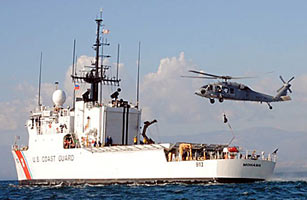
A U.S. Navy helicopter delivers humanitarian supplies to the Coast Guard's Mohawk off the coast of Port-au-Prince, Haiti
When the U.S. Coast Guard arrived in Haitian waters with relief supplies on Jan. 14, it was overwhelmed by people who needed medical attention. Their supplies were low and their equipment rudimentary. As first responders to the disaster, the Coast Guard had a lot of improvising to do. "The first few days we were taking tree branches and breaking them for splints," says OS1 James Sweetman, who was originally assigned to help out with security at a makeshift medical clinic at Admiral Killick Naval Base in the capital's Carrefour district. "We cut wool blankets for slings and made backboards out of doors."
Immediately after the quake, hundreds of injured people converged on Killick. Sweetman describes how people in the crowd, though docile, frantically directed him and his colleagues to injured friends and family members. "Once you went into the crowd, you had 10, 15 people grabbing you, saying, 'Come with me. Come with me,' because everybody had someone who was hurt," he says. "Some people were there four to five days before we could see them. But not one person got hostile. Nobody was angry. Everyone understood. They had hope on their faces. They knew we were there to help."
Roughly 40 seamen dispatched from two Coast Guard cutters, the Tahoma and the Mohawk, had to hold down the fort, treating some 350 patients, until the U.S. Navy arrived with backup and the U.S.N.S. Comfort, a hospital ship that has seen duty tending to troops injured in the Iraq war. The scene at Killick went from one of chaos, in which seaman early on performed surgeries on the floor, to one in which quake casualties received top-of-the-line medical care.
Coast Guard officers are trained to handle mass casualties, but the situation in Haiti differed from anything that anyone on the Tahoma or Mohawk had ever experienced. There were no helicopters or ambulances to evacuate the severely injured, says medical corpsman HS1 Larry Berman. He and HS2 Elias Gomez helped run the Killick clinic alongside their fellow seamen. Several Haitian nurses and a Haitian obstetrician helped out after their hospital was closed because of quake damage.
One of the more trying aspects of the rescue mission involved deciding who among the Haitians got treated and when, says Berman. Triage entailed dividing people into groups based on the severity of their injuries. Of the four triage categories, Category 0 is the worst, meaning that medical professionals deem the case beyond hope of survival. Berman recalls three people placed in that category, including a young Haitian man whose left arm was so badly crushed from the shoulder down that Berman described it as "all soup." He also had a head wound.
"The back of his head was open, and there were maggots in the wound," Berman says. He was convinced that the man wasn't going to make it. But he couldn't get him out of his mind. "That night as I lay in bed, I thought about this guy and I thought about him and I thought about him," Berman says. "The next day, he was still alive. I decided, If he has the strength to survive the night, he deserves to be treated." So Berman scrubbed the arm that would eventually be amputated and sealed it in a red plastic hazardous-waste bag, so there would be no mistaking what would happen to the limb. Elias, the ship's doc on the Mohawk, then put 30 staples in the man, from across his head to the bridge of the nose, and sutures along his eyebrow and lid on the left side of his face. Lastly, Berman says, he used tweezers to remove "one at a time, 200 maggots from the wounds" in his head. "He was the No. 1 guy we evacuated out," Berman says.
A Coast Guard helicopter would fly the injured to Sacred Heart Hospital in Milot, a fully operational hospital set up to handle 200 patients, as well as to the Comfort and Navy vessel Bataan. Lieut. Commander Jim Stancil, a medical planner for the Comfort, described how his ship had increased in capacity since departing its berth in Baltimore. It went from six operating rooms to eight, and has the capacity to increase to 12 ORs, depending on how many operating teams are available. There are 500 beds with bunks, so it can accommodate 1,000 patients, he says. The ship's crew of 750 increased to 1,100 when it picked up doctors and nurses from Guantánamo Bay on Thursday.
While the hospital ship aims to assist in the initial stages of the recovery, at some point the Navy would like to hand off to USAID and nongovernment relief organizations, Stancil says. "We want to rotate out of Haiti," Stancil says, explaining that the military's first priority is the troops in Iraq and Afghanistan. However, he had no timetable as to when the commitment to Haiti will run out, simply stating, "We're in it for the duration."
Commander Kathleen Grudzien, the head nurse in the pediatrics floor on the second deck, says the ship was built to serve in war zones, pointing out that "the forward wards were for enemy prisoners of war." Grudzien says she saw a lot of catastrophic injuries in war zones and that the Haiti situation is more controlled. The patients come to them after having already received initial treatment, and they are stabilized, she says. None that have come aboard have died on her watch, she says. Amid all the talk of crushed and broken bones, there is the occasional bright spot, says Grudzien. A young Haitian woman gave birth to a son aboard the aircraft carrier U.S.S. Carl Vinson. Mother and baby Vinson are doing fine.
Read more in the new book TIME Earthquake Haiti: Tragedy and Hope and support TIME Haitian relief efforts